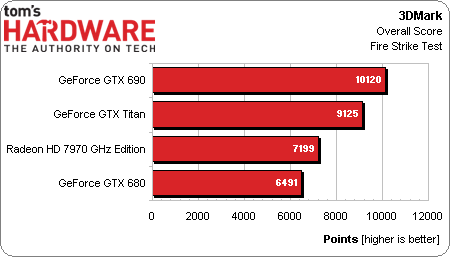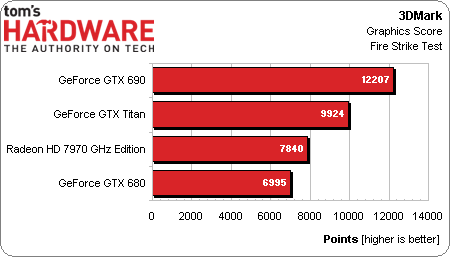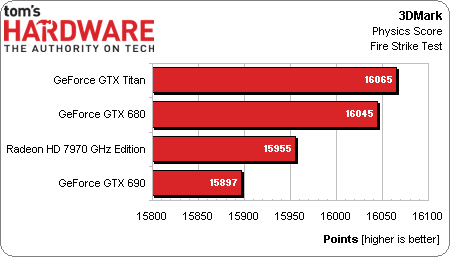Benchmarking GeForce GTX Titan 6 GB: Fast, Quiet, Consistent
We've already covered the features of Nvidia's GeForce GTX Titan, the $1,000 GK110-powered beast set to exist alongside GeForce GTX 690. Now it's time to benchmark the board in one-, two-, and three-way SLI. Is it better than four GK104s working together?
Results: 3DMark
The one benchmark we didn’t subject to Fraps-based logging was Futuremark’s new 3DMark. More than anything, we wanted to run these four cards through the latest synthetic, which attempts to represent the future of gaming through two graphics tests, a physics test, and a fourth benchmark intended to apply GPU and CPU loads simultaneously.
Futuremark’s Overall suite score is calculated using a weighted harmonic mean to consider the Graphics, Physics, and Combined sub-tests. Leaving our six-core CPU in place, running at 4.5 GHz, and swapping out graphics cards shows us that Nvidia’s GeForce GTX 690 is still the fastest card in our lab. The Titan follows behind, though, at the same $1,000 price point, we know which card we’d rather have.
AMD’s Radeon HD 7970 GHz Edition deserves a special call-out. The least-expensive board is currently $430 on Newegg—less than the cheapest GeForce GTX 680. Over the course of time, and with more mature drivers, Tahiti-based cards have picked up significant momentum. Two of them should have little trouble outrunning a GTX 690 (and for $140 less). In fact, they do. I have a pair of vanilla 7970s here—not the GHz Edition boards—and they do 11,629 points in 3DMark.
In a pure look at graphics performance, the outcome is similar, albeit more pronounced. GeForce GTX 690 finishes up on top, with Titan landing between the 690 and AMD’s Radeon HD 7970 GHz Edition.
Get Tom's Hardware's best news and in-depth reviews, straight to your inbox.
Current page: Results: 3DMark
Prev Page GeForce GTX Titan: Putting Rarified Rubber To The Road Next Page Results: Battlefield 3-
Novuake Pure marketing. At that price Nvidia is just pulling a huge stunt... Still an insane card.Reply -
whyso if you use an actual 7970 GE card that is sold on newegg, etc instead of the reference 7970 GE card that AMD gave (that you can't find anywhere) thermals and acoustics are different.Reply -
cknobman Seems like Titan is a flop (at least at $1000 price point).Reply
This card would only be compelling if offered in the ~$700 range.
As for compute? LOL looks like this card being a compute monster goes right out the window. Titan does not really even compete that well with a 7970 costing less than half. -
downhill911 If titan costs no more than 800USD, then really nice card to have since it does not, i call it a fail card, or hype card. Even my GTX 690 make more since and now you can have them for a really good price on ebay.Reply -
spookyman well I am glad I bought the 690GTX.Reply
Titan is nice but not impressive enough to go buy. -
hero1 jimbaladinFor $1000 that card sheath better be made out of platinum.Reply
Tell me about it! I think Nvidia shot itself on the foot with the pricing schim. I want AMD to come out with better drivers than current ones to put the 7970 at least 20% ahead of 680 and take all the sales from the greedy green. Sure it performs way better but that price is insane. I think 700-800 is the sweet spot but again it is rare, powerful beast and very consistent which is hard to find atm. -
raxman "We did bring these issues up with Nvidia, and were told that they all stem from its driver. Fortunately, that means we should see fixes soon." I suspect their fix will be "Use CUDA".Reply
Nvidia has really dropped the ball on OpenCL. They don't support OpenCL 1.2, they make it difficult to find all their OpenCL examples. Their link for OpenCL is not easy to find. However their OpenCL 1.1 driver is quite good for Fermi and for the 680 and 690 despite what people say. But if the Titan has troubles it looks like they will be giving up on the driver now as well or purposely crippling it (I can't imagine they did not think to test some OpenCL benchmarks which every review site uses). Nvidia does not care about OpenCL Nvidia users like myself anymore. I wish there more people influential like Linus Torvalds that told Nvidia where to go.



